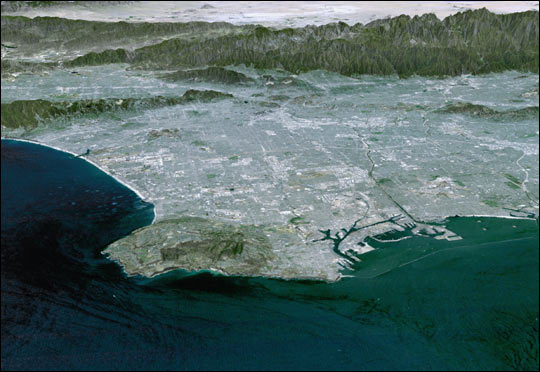A few days ago, Swiss engineers “halted an experiment to extract geothermal heat from deep below ground after it set off a small earthquake in the nearby city of Basel.” Nonchalantly described as a “mishap,” the earthquake “occurred after water was injected at high pressure into a five-km-deep (16,000-feet-deep) borehole.”
The idea that some earthquakes might have a human origin totally fascinates me. When it was suggested last year, for example, that Taipei 101, one of the tallest (and heaviest) buildings on earth, may have re-opened an old tectonic fault beneath Taiwan, what went otherwise unexplored was the possibility that some buildings might achieve the exact opposite: through sheer mass and fortuitous location, a building could perfectly weight a faultline… preventing it from rumbling again.
Think of it as a geological piano damper: a building—a whole city—that puts an end to earthquakes. (Yes, I’m aware of this film).
 [Image: Los Angeles against the mountains; courtesy of SRTM Team NASA/JPL/NIMA].
[Image: Los Angeles against the mountains; courtesy of SRTM Team NASA/JPL/NIMA].
Having recently moved to Los Angeles, I find myself thinking about earthquakes quite a lot; but I also find myself wondering if the surprising lack of seismic activity in the greater Los Angeles area over the past century has been precisely because of the amount of buildings out here. Is it possible that Los Angeles itself—this massive urban obesity—is a kind of anti-Taipei 101? In other words, it’s so massive and heavy that it has shut down the major tectonic faults running beneath the city?
For instance, I would love to discover that the Los Angeles freeway system performs a kind of constant seismic massage on local tectonic plates by spreading the tension outward. Specific bus lines, say—traveling north on Figueroa, or down La Brea, or west on Venice—have the totally unexpected effect of massaging local tension out of the earth.
Whole new classes of vehicle could come into existence; like hyper-industrial street-cleaners, these slow-rolling, anti-earthquake machines would drone through the twisting, fractal valleys of Hollywood, pressing strain out of the bedrock.
In fact, I’m reminded of David Ulin’s book The Myth of Solid Ground, where we meet a man named Donald Dowdy. Dowdy, who found himself under FBI investigation for taunting the United States Geological Survey with “a bizarre series of manifestos, postcards, rants, and hand-drawn maps, forecasting full-bore seismic apocalypse around an elusive, if biblical, theme,” also claimed that, “in the pattern of the L.A freeway system, there is an apparition of a dove whose presence serves to restrain ‘the forces of the San Andreas fault’.”
It’s absurd, of course—and yet I find myself wondering: if more and more people were to move to Los Angeles, and more and more buildings were to be constructed, perhaps we might hold the faults in place for a while—a decade, a century—before the earth regains the strength to break free.
(Meanwhile, be sure to check out my interview with David Ulin over at Archinect).
The idea that some earthquakes might have a human origin totally fascinates me.
Hundreds of quakes in Utah seem to be related to a rather dubious desalinization technique for the Colorado River. It involves pumping roughly 250 gallons of water per minute into some very deep wells along the Utah-Colorado border.
Biggest quake thusfar was 3.9, if memory serves.
You should also check out the novel Strong Motion by Jonathan Franzen, the central theme of which is seismic activity in Massachusetts.
Not a patch on The Corrections, but worth a read.
wow, you live in la, does that mean i saw you at norfolks talk at lacma?
Yep. What’d you think of the talk?
Ooo thought provoking stuff!
funny! buses massaging the earth’s tension away!!
this comment comes late, but i was reminded of this post during an earth science class this afternoon.
the san andreas fault is of the transform variety; the plates run parallel in opposite directions. earthquakes happen because the crust bends elastically as the plates move, and then the brittle earth eventually snaps. basically.
my prof didn’t think any city, even LA, could hold the plates in place enough to prevent earthquakes. but he was intrigued by the idea that constant construction might be continually breaking the brittle earth around the plate boundary, preventing the elastic stretch and subsequent snap that causes earthquakes.
i wonder if there is some geologic research on this?